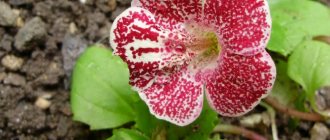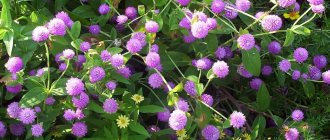These are charming late spring flowers, related to strawberries, raspberries and other members of the Rosaceae family. Few plants are so versatile, easy to grow, and yet so much fun for gardeners. They surround us quite often in the wild - you just need to know where to look! We will tell you how to grow gravilat - planting and care in open ground, and present photos of species and varieties.
Description of the plant gravilat
The perennial plant gravilat belongs to the Rosaceae family. The Russian botanical name gravilat comes from the Russified Latin name for the clove root “radixcaryophyllatae” (caryophyllate).
Gravilat is a herbaceous plant up to 60 cm high. It has a thick, oblique, creeping, unbranched rhizome on which a leaf rosette is formed. The stem of the plant is straight, has edges and a soft edge, branches weakly, and closer to the top it is covered with white hairs.
The leaves located at the root have long petioles, they are intermittent, imparipinnate, with a large outermost lobe and 3-9 rounded-ovate, unevenly serrated leaflets. There are few stem leaves. They consist of 3 parts and have short petioles. The upper leaves consist of 3 lobes. The leaves are covered with a small amount of hairs on both sides.
Flowers of garden varieties of the plant are 3-4 cm in diameter. They are open, with smooth or double petals of white, red, yellow, pink, orange and other shades. The calyx consists of two rows of sepals - 5 large internal and 5 small internal.
Gravilata flowers may face upward or bell-shaped. There are often 5 petals, but there are varieties that have more. Gravilata inflorescences have the shape of a panicle or umbrella and consist of 3-4 flowers.
Flowering time and its duration depend on the plant variety. Some varieties bloom twice: from May to July and from August to October, some bloom all season without interruption. For most varieties, flowering time falls in mid-summer: in this case, gravilat flowers appear in late June-early July, flowering continues for about two months.
The plant is pollinated by insects. After flowering, a fruit is formed, making it possible to grow from seeds. The fruit consists of many hairy nuts - seeds with long hooked spouts at the end, with which they cling to animal fur or human clothing and thus spread. The fruits ripen in September.
Application
Gravilate is used in many areas, for example, in cosmetology, folk medicine, designers use it as decoration in gardens, and even in cooking. Like many plants, Gravilat has its pros and cons.
Useful properties of the flower
A large number of valuable microelements are contained in the roots and stems. Decoctions of them or plant powders help the body with:
- For colds;
- Acts as an antibacterial agent;
- Antimicrobial;
- Hemostatic agent;
- Antiemetic.
Many peoples in whose territory this plant grows are produced and used for various diseases.
In cosmetology, Gravilat is used for soothing baths, to remove severe calluses, and face masks are useful for people suffering from oily skin.
Advice: Before using decoctions, masks or infusions from the Gravilat plant, make sure that you do not have allergies.
Contraindications
It may be dangerous to use Gravilat for people with allergies. If used and consumed incorrectly, problems with the central nervous system and respiratory tract may occur. To prevent anything like this from happening, you must follow the daily norm and not violate the recipe.
Be healthy!
May your life be as beautiful as Gravilata flowers!
Gravilat: varieties and varieties
The flower is represented by 50 species. The most popular are city gravilat, river gravilat, mountain gravilat, Chilean gravilat, Aleppo, Bulgarian, Canadian and others. 20 species with decorative properties are grown.
Most varieties are of the Chilean or streamside variety. In addition, there is a group of hybrid varieties. The most famous varieties of the Chilean variety in our country:
- Lady Stratheden with yellow double flowers up to 4 cm in diameter, collected in panicles. The flowering time of the variety falls at the end of July-beginning of August and lasts 45-60 days.
- Another variety of the Chilean variety of gravilat is Mrs. Bradshaw. This plant is up to 80 cm high with large red double flowers, winter-hardy, can withstand down to -29°C.
- Blazingsunset. Characterized by abundant bright flowers. Flowering time is continuous from June to September. The variety is characterized by the formation of bushes from embossed leaves. With its help you can decorate a flower bed around the perimeter or the front edge of a border.
- Doublesunrise. The inflorescences of this variety have the shape of a basket with red flowers.
- Cosmopolitan. Large, double flowers of this variety have an interesting petal color: cream with pink edging.
- The Fireball variety is characterized by scarlet-orange color of flowers. They are large, sometimes more than 4 cm in diameter. The plant blooms in July for a month.
- Golden ball. The variety is characterized by yellow flowers. Flowering time of the variety: from May to August.
Popular hybrid varieties:
- Fire fell. It is characterized by red-orange flowers.
- Gladys Perry. The variety has bright red flowers.
- Princess Juliana with dark yellow flowers.
- Ruby. Flowers of the variety are carmine or scarlet.
The most popular variety of the riverside type of gravilat is Leonardo Var. It has a tall (up to 75 cm) stem with a reddish edge. The color of the drooping, bell-shaped flowers is different: copper-pink, bronze, red-brown, yellow with red veins.
Features of reproduction
Chilean gravilate can be propagated by seeds, which are collected in the fall, when they are finally ripe. They can be planted in spring or late summer.
The second method is to divide the bush, but no more than four times a season. Overgrown bushes should be carefully dug up and the rosettes with part of the roots should be separated. All parts must be planted immediately in a permanent place, maintaining distance.
Advice! Until the bushes take root, it is better to water them daily in dry weather without flooding the plants.
Plant care
Gravilat, planting and caring for which is quite simple, does not require special growing conditions. He is unpretentious and almost not susceptible to disease.
Subtleties of landing
Gravilat is not picky about the soil. It can grow on clay, loamy soil, sand, and peat. But too damp and acidic soils are not suitable for perennials, so the area must be well drained before planting. To do this, add mulch or sand to the soil. Gravilat normally tolerates moderate shade, but develops better in well-lit areas. In this case, flowering occurs earlier.
Seedlings can be planted in spring or autumn. The bushes are planted at a distance of 20-30 cm from each other. They will quickly grow and fill empty spaces. Before planting, add compost, humus, mullein or other organic fertilizer to the holes. Seedlings or cuttings are planted in the prepared holes and the soil is moistened abundantly.
Fertilizers and watering
The perennial requires regular moderate watering under the roots. It is important to remember that the plant does not tolerate prolonged waterlogging. If the area is swampy or located in a damp lowland, the flowerbed with gravel should be raised and drained. Streamline varieties can also withstand waterlogged soils.
Before flowering begins, mineral fertilizing containing nitrogen, phosphorus and potassium fertilizers is applied to the soil. During flowering, in order to prolong it, the plant is fed twice with phosphorus-potassium fertilizers.
Transfer
The plant does not tolerate transplantation well, but the flower needs to be replanted and the bush divided every 4 years. The procedure promotes more intense flowering, active growth and development of the plant.
The bushes need to be replanted in soil prepared as for planting in spring or autumn after flowering has completed. Replanting may be necessary if the plant's rhizome is affected by rot. The soil must be treated with a special preparation.
Gravilate: care after flowering
In order to prolong flowering, it is important to regularly prune already faded flowers.
For the winter, perennials, especially hybrid varieties or plants with double flowers, require shelter from spruce branches or dry foliage.
Landing
Gravilat is unpretentious to the soil , so it can be planted almost anywhere, with the exception of acidic soils, which it does not tolerate and can wither on them.
also choose a well-lit place , so that the flower can open normally, and the plant itself will not wither from lack of sunlight.
Gravilat does not tolerate low temperatures , so it is best to plant it in a greenhouse, where even in winter you can easily maintain a suitable temperature. Transplantation into the soil is usually done after 3 leaves appear on the sprout, this indicates the readiness of the plant. If you transplant a flower earlier, it may not get used to the new place, not get used to the soil and die.
The soil on which it is planned to plant gravilat must also be specially prepared. The soil needs to be fed, making it more saturated with organic substances and minerals. Compost is suitable for this, which is sold in any gardening store, or peat, which is more difficult to obtain and can only be found in large centers specializing in the sale of plant products. You can also use manure, but it must be diluted with water so that it is not dangerous for plants due to its concentration of biologically active substances. After fertilizing, the soil must be moistened with water.
Gravilat in landscape design
Low-growing varieties are planted along the perimeter of lawns and ponds, along borders. Hybrid gravilate is an excellent herbaceous plant for open ground. This is facilitated by their unpretentiousness to growing conditions, long flowering and decorativeness of the bushes, which, thanks to the bright green leaves of an interesting shape, look interesting even after flowering.
The looseness of the inflorescences does not allow the plant to be used as the main element of landscape compositions. At the same time, gravilate creates an excellent background and fills the flower beds with color.
The height of the plant to maintain the appearance of the composition can be controlled by changing the distance between the shoots, the amount of fertilizer, using various chemicals, for example, spraying paclobutrazol.
Gravilate photo.
Beneficial features
The rivulet and urban species of the plant can be used for food. Young stems and leaves are suitable for making salads and soups. They contain tanning and various biologically active components. The plant is also rich in essential oil and organic acids.
Infusions and various teas from gravilate of these varieties are used as an antibacterial, mucolytic, hemostatic, and sedative.
Gravilat is an excellent addition to any flower bed decorated with ornamental vegetation. You can also arrange a beautiful bouquet. And some types of plants have excellent medicinal properties.
Preparing for winter
Despite the good frost resistance of gravilate, it is better to cover it with special materials in winter. To do this, you can use agrofilm purchased at a hardware or hardware store. It will not allow oxygen to linger inside the shelter, the plant will “breathe” freely through the warm shelter.
You can also use spruce branches. Spruce or pine branches will perfectly warm the plant and protect it from damage by snow cover, and will also allow oxygen to freely penetrate inside the shelter directly to the flower. The gardener himself decides which option is most profitable and convenient in a particular case.











